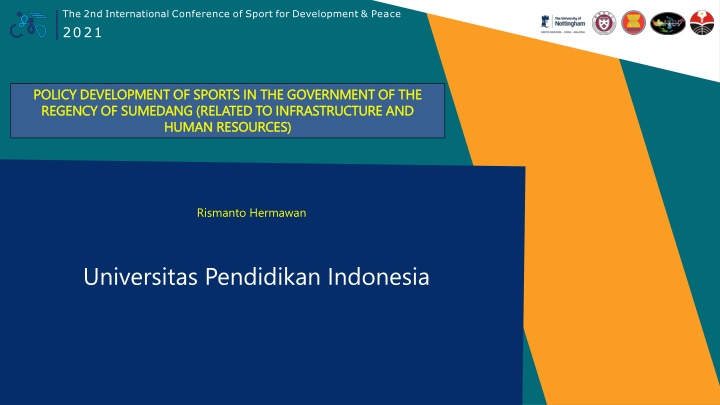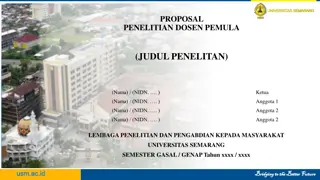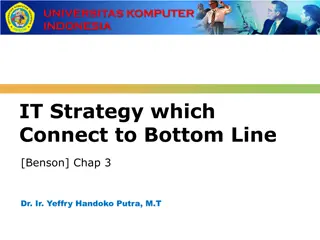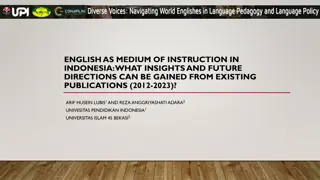
Sports Policy Development in Sumedang Regency: Infrastructure & Human Resources
Explore the policy development of sports infrastructure and human resources in Sumedang Regency, emphasizing the importance of sports facilities and the role they play in community health and fitness. The research methodology, data analysis, and key findings are outlined in detail.
Download Presentation

Please find below an Image/Link to download the presentation.
The content on the website is provided AS IS for your information and personal use only. It may not be sold, licensed, or shared on other websites without obtaining consent from the author. If you encounter any issues during the download, it is possible that the publisher has removed the file from their server.
You are allowed to download the files provided on this website for personal or commercial use, subject to the condition that they are used lawfully. All files are the property of their respective owners.
The content on the website is provided AS IS for your information and personal use only. It may not be sold, licensed, or shared on other websites without obtaining consent from the author.
E N D
Presentation Transcript
The 2nd International Conference of Sport for Development & Peace 2021 POLICY DEVELOPMENT OF SPORTS IN THE GOVERNMENT OF THE POLICY DEVELOPMENT OF SPORTS IN THE GOVERNMENT OF THE REGENCY OF SUMEDANG (RELATED TO INFRASTRUCTURE AND REGENCY OF SUMEDANG (RELATED TO INFRASTRUCTURE AND HUMAN RESOURCES) HUMAN RESOURCES) Rismanto Hermawan Universitas Pendidikan Indonesia
Introduction Sports facilities and infrastructure play an important role in maintaining community health and fitness (Bergsgard et al., 2019). The facilities themselves are one of the important elements that must be owned in sports (Rafoss & Troelsen, n.d.). In the Law of the Republic of Indonesia Number. 3 of 2005 concerning the National Sports System in article 1 paragraphs 20 and 21 states that sports infrastructure is a place or space including an environment used for sports activities and/or sports organization. While sports facilities are equipment and supplies used for sports activities (Law No. 3 of 2005, 2005). Law Number 3 of 2005 concerning the National Sports System
Methods This research method is qualitative research. The research approach used in this study is a phenomenological approach. Participants This research was carried out in Sumedang Regency, especially the Department of Tourism, Culture, Youth and Sports as policy makers for sports education and recreation and KONI Sumedang as policy makers for achievement sports. Instrument The instrument used is not a questionnaire or a test, but a researcher. However, to guide the conduct of the research, the researcher made a number of guidelines that were prepared based on the national sports system law and based on research problems, research sub-problems, aspects observed, data sources, guidelines used in observations, interviews and documentation. Procedure 1. pre-field stage 2. field work stage 3. data analysis stage - Member Check - Data Triangulation - Confidentiality
Data analysis The data analysis used in this study using qualitative methods was carried out through four stages according to Miles et al., (2013: ) which is described as follows: Figure 1 Stages of Data Processing in Qualitative Methods (Miles & Hubberman)
Result TABLE 1 POLICY CONCEPT ANALYSIS UU SKN Regional Regulation on Sports RPJMD Article 17 Improvement and Development of Facilities / Tourism and Sports Infrastructure Sports Facilities Controlling the development and improvement of sports facilities and infrastructure. Controlling the facilitation and support of cross-district sports activities Article 17 Controlling the development and supervision of the youth sector Controlling the coaching, development and management of sports Controlling the organization of sports weekends and championships Controlling sports education, training and funding Controlling the improvement of the professionalism of athletes, coaches, managers and sports coaches Controlling the empowerment and promotion of sports as well as improving the physical fitness of the community Increasing the number of athletes being trained Improved youth organizations that are fostered Enhancement of fostered youth Improving the implementation of community sports Human Resources
Result Sports Facilities and Infrastructure in Sumedang Regency no no Aspect/Focus/Sector of Affairs/Regional Development Performance Indicators unit Initial working conditions Performance achievement targets Final performanc e condition 2014 2015 2016 2017 2018 1 Percentage of people who receive services or sports coaching Persen 60,00 80,00 100,00 100,00 100,00 100,00 100,00 2 Improvement of youth and sports service facilities persen 70,00 80,00 90,00 100,00 100,00 100,00 100,00 Table 2 REGIONAL PERFORMANCE INDICATORS ON PERFORMANCE ACHIEVEMENTS IN THE IMPLEMENTATION OF GOVERNMENT AFFAIRS OF SUMEDANG REGENCY 2014-2018 Quantity and Quality of Human Resources in Sports Development in Sumedang Regency a. Athlete b. Coach
Conclusion The results show that the facilities and infrastructure available in Sumedang Regency, for sports education in general are relatively adequate, although there may be some schools that are relatively not sufficient, meanwhile for achievement sports and recreational sports the infrastructure is still relatively far from optimal. . Human resources in the field of sports in Sumedang Regency can be said to be still relatively lacking. So it still needs to be improved, including coaching athletes from an early age, increasing the ability or competence of coaches and other sports personnel that still need to be improved.
Reference Arikunto, Suharsimi. (2002). Metodologi Penelitian. Penerbit PT. Rineka Cipta. Bergsgard, N. A., Borodulin, K., Fahlen, J., H yer-Kruse, J., & Iversen, E. B. (2019). National structures for building and managing sport facilities: a comparative analysis of the Nordic countries. Sport in Society, 22(4), 525 539. https://doi.org/10.1080/17430437.2017.1389023 Hallmann, K., Wicker, P., Breuer, C., & Sch nherr, L. (2012). Understanding the importance of sport infrastructure for participation in different sports - findings from multi-level modeling. European Sport Management https://doi.org/10.1080/16184742.2012.687756 Harsono. (2008). Pengelolaan perguruan tinggi.Yogyakarta: Pustaka Pelajar. Miles, M. B., Hubberman, M., & Saldana, J. (2013). Qualitative Data Analysis A Sourcebook 3rd edition. In SAGE Publications. 4622(98)00172-0 Moleong, Lexy J. 2007. Metodologi Penelitian PT Remaja Rosdakarya. Rafoss, K., & Troelsen, J. (n.d.). Sport in Society: Cultures , Commerce , Media , Politics Sports facilities for all? The financing , distribution and use of sports facilities in Scandinavian countries. December 2014, 37 41. https://doi.org/10.1080/17430431003616399 RPJMD KAB SUMEDANG TAHUN 2018-2023. (n.d.). RPJMD KAB SUMEDANG TAHUN 2018-2023. UU No 3 Tahun 2005. (2005). Undang-Undang Republik Indonesia Nomor 3 Tahun 2005 Tentang Sistem Keolahragaan Nasional Dengan. Presiden RI, 1, 1 53. Sugiyono. 2010. Metode Penelitian Pendidikan dan R&D. Bandung: Alfabeta Jakarta. Quarterly, 12(5), 525 544. Methods https://doi.org/10.1016/S0301- Kualitatif. Edisi Revisi. Bandung : Pendekatan Kuantitatif, kualitatif, Thank you for your concern














